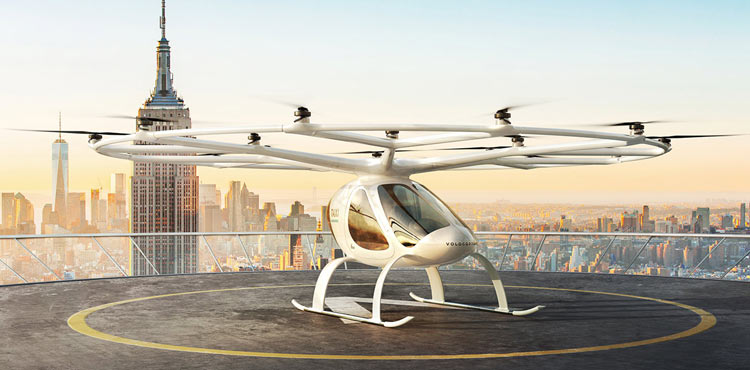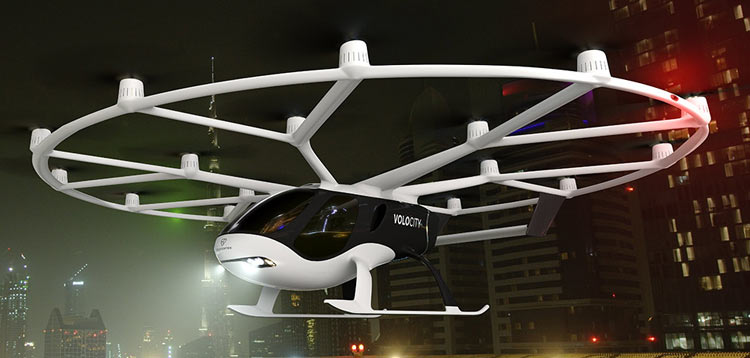
While integrating autonomous features in modern vehicles, leading auto companies are exploring the future of urban mobility in the aviation industry. The emerging concept of air taxis reflects the dramatic transformation that is underway in the automotive industry.
With a mounting number of cars on roads, especially in urban areas, the transportation industry is undergoing a crisis with traffic management among many other issues. Consequently, amidst the current revolutionary inventions in fully autonomous vehicles, air taxis are evolving as a whole new class of automobiles that is poised to metamorphose the future of mobility. This is triggering automakers to foray into the urban air mobility (UAM) ‘landscape’, ultimately fueling innovation in designs of air taxis.
Even though ‘a flying car’ or an e-air taxi conveys an impression from fiction, the reality is- Air taxis are nearing commercial availability. This article dives into the reality of ongoing research and innovation activities in UAM and how they can bring the future of air taxis closer than anybody ever imagined.
The Revolutionary Concept of Air Taxi: Reality or Fiction?
"Mark my word: A combination of airplane and motorcar is coming. You may smile, but it will come." The founder of The Ford Company – Henry Ford envisaged the invention of flying cars back in 1940, and eighty years later, the world is ready to witness his prediction coming true. A convergence of next-generation technologies is creating a promising future for UAM and air taxis with practicability and commerciality.
The heightened need for faster, cleaner, safer, and more affordable modes of transportation is triggering automakers to explore the potential of the vertical takeoff and landing (VTOL) technology in the evolution of air taxis. Furthermore, with the advent of state-of-the-art battery technology, the evolution of electric VTOL (eVTOL) is enabling automakers to bring three-dimensional electric mobility in reality. In the coming years, the convergence of the automotive industry and electric aviation industry is expected to support in making air taxi a ground reality!
While automotive electrification and aviation make the foundation of the air taxi concept, technological advancements in the eVTOL aircraft development signify the most recent advancements in the designs of air taxi. Ongoing developments in the battery industry and battery management systems are expected to have a paramount impact on the adoption of eVTOL technology in air taxis’ futuristic designs.
What is Happening in the Industry?
A mounting number of automakers and leading players in the shared mobility industry, as well as the aviation industry, are entering the global market for air taxis to gain the first mover’s advantage. Uber, Porsche, and Boeing are among the front-runners in the air taxi market that are investing heavily in their models of autonomous air taxis to improve their safety features as well as affordability. Though the number of competitors is small in this space for air taxis, soon the race to the skies is expected to get more competitive with time, as new businesses are poised to sprout up in this market.
Airbus is one of the leading aviation companies to develop air taxis with different capacities such as one-seater or a personal air vehicle called Vahana and four-seater compact air taxis called CityAirbus. The first successful flight of the CityAirbus, which uses the eVTOL technology, was realized in May 2019. The company’s plan to commercialize the air taxi models for Vahana and City Airbus by 2020 and 2023, respectively.
Another company to successfully enter the air taxi industry is a Munich-based start-up called Lilium, which unveiled its on-demand air taxi service with a five-seater prototype in May 2019. Lilium Jet – the company’s all-eVTOl device – carries the capacity to complete long journeys within the range of 300km. The company announced in May 2019, that the next milestone for its new air taxi will be to achieve a transition from vertical take-off to horizontal flight and to commercially launch an emission-free air taxi by 2025.

Volocopter is another German start-up that has introduced its fourth-generation eVTOL air taxi named the VoloCity, in 2019. It is a two-seater, 18-rotor eVTOL device with a top speed of around 70mph and a range of approximately 35km. The company announced that its next goal is to focus on developing a suitable infrastructure and ecosystem with an efficient air traffic control system.

The number of active participants in the world’s air taxi market is increasing at an impressive rate, yet some significant challenges are making the world doubt the viability of the concept of air taxi.
Hurdles in Making Air Taxis a Reality
While optimism about the emergence of air taxis into the reality is at its peak right now, some critical barriers need to be overcome for a successful commercial launch. One of the most important challenges is the regulations and standards established by international bodies such as the European Union Air Safety Agency (EASA). Though many governing bodies are welcoming the new air taxi modules, stringent regulations on their deployment and safety will continue to influence manufacturers’ strategies.
Furthermore, the complexity of air traffic management and its manual approach due to human controllers has been creating uncertainties about the sustainability of the mass uptake of air taxis. In addition, while current infrastructures are competent enough to support trials, they still lack the efficiency required for these businesses on a large scale. Apart from these, noise cancellation and battery energy density also continue to remain the top technological challenges for stakeholders in the air taxi market.
Nevertheless, considering the speed at which the market is evolving, the next decade is expected to reflect a brighter future for air taxis. The automotive industry is converging with the electronics & telecommunications and Information Technology (IT) industries to enter the future of fully electric and driverless vehicles on as well as above the ground. Eventually, the ongoing research and development technologies will continue to reiterate the fact that, the sky is the limit for innovations in the air taxi industry!






Thank you for your valuable information. I want more people to benefit from it.